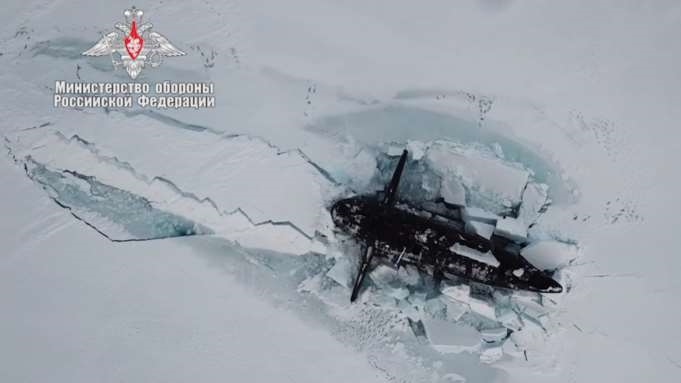Three Russian submarines made their way to the surface several feet apart in the Arctic, several feet of sea ice - one of the most difficult naval maneuvers has been achieved.
A video released by Russia's Defense Ministry shows the towers of the three men breaking a continuous sheet of ice floating near the French Joseph Land Peninsula in the Pacific north of the Black Sea. Are
Amaka 2021 (meaning "polar bear" in the Siberian outpost) is participating - a 19th non-governmental organization based in the region for a campaign involving 600 military and civilian personnel, including staff from the Russian Geographical Society. Century
The commander of the Russian navy, Admiral Nikolai, said, "for the first time in the history of the navy," for the first time in the history of the navy, the three submarines were submerged together within a thousand feet (300 meters) of each other through 5 feet thick (1.5 meters) of ice. Log in Yuminov told Russian President Vladimir Putin in a televised video call.
According to the Admiral, the conditions in the region were between minus 13 and minus 22 degrees Fahrenheit (minus 25 and minus 30 degrees Celsius), with strong winds blowing up to 70 miles per hour (110 kilometers per hour).
Surface submarines
Surfing a submarine through thick sea ice is not an easy task. According to Popular Mechanics' 2018 article on American submarines in the Arctic, careful preparation is required to explode through the ice.
Nuclear-powered missile submarines typically try to hide under Arctic ice because it effectively hides them from enemies. But when they have to come to the surface, the sub-commander will first try to find patches near the open water - such as "lead" or "polynia" - where they can go to the surface without encountering any floating ice.
When that fails, you need to maneuver carefully so that the submarine can hit 9 feet (2.5 meters) of sea ice.
The first task is to slowly raise the submarine until its upper tower contacts the bottom of the floating ice sheet. The compressed air is then used to push the seawater out of the submarine's ballast tanks, creating an upward force, which even pushes the ice.
It is especially difficult to get three submarines to break the ice at the same time because underwater vessels cannot communicate with each other.
Arctic expedition
Although this is the first time Russian submarines have appeared together on the ice, this is not the first time.
Popular Mechanics reports that two US submarines - USS Connecticut and USS Hartford - passed through Arctic ice and came under the watchful eye of British submarine HMS Trent in 2018.
The Russian military did not name the three ships that took part in the recent operation, but the Barents Observer news site identified them as two Delta IV nuclear-powered ballistic missile submarines - during the Cold War. The largest base of the Soviet submarine fleet. A new sack class all The name of the class comes from the Greek god of northern wind, Borias.
It is estimated that each Russian submarine is capable of carrying 16 ballistic missiles, and each missile can carry six nuclear warheads.
The Amka 2021 expedition began on March 20 under the command of the Russian Navy near the Russian Franz Josefland Peninsula.
"According to the same concept and plan, for the first time in the circular areas, a complex process of military training, scientific research, and practical measures in different directions is being carried out," Yumanov told Putin in a video call.
One important result, he said, was the confirmation of the "technical characteristics" of various weapons systems, military equipment, and special equipment at different longitude and low-temperature conditions.
Russia has suggested that the Arctic could become a major shipping lane, with nuclear-powered "icebreaker" ships navigating the sea ice.








0 Comments